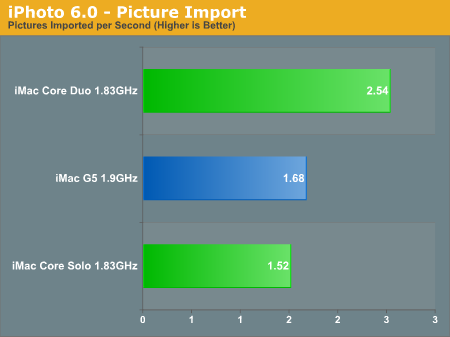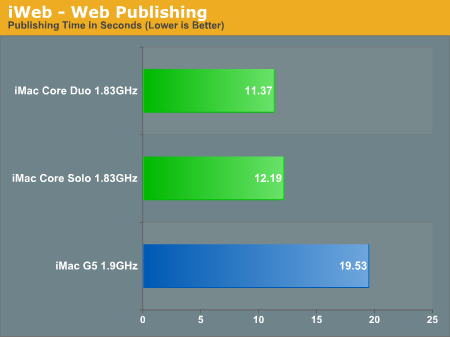Apple Makes the Switch: iMac G5 vs. iMac Core Duo
by Anand Lal Shimpi on January 30, 2006 11:26 PM EST- Posted in
- Mac
iLife '06 Performance with iPhoto, iDVD and iWeb
With iPhoto, Apple has really created an excellent digital photo album application that is extremely robust. Steve Jobs is always demonstrating how iPhoto can handle tens of thousands of pictures without a problem, but given that I am testing iMacs with 512MB of memory, I'll stick to our paltry 379 photos as the data for this next test.
The test is simple; I timed the import of all 379 photos into iPhoto which, believe it or not, is quite CPU intensive and not as I/O bound as you'd think. After I attained the time, I divided it into 379 to get the number of pictures imported per second. Like many operations in OS X, the iPhoto import process is multi-threaded, giving the Core Duo an inherent advantage over the G5. So, I've included Core Solo performance in the chart below as well:
Next up is iDVD, an application that you can use to create DVDs that are playable on any consumer DVD player. There are, once again, two aspects to performance in iDVD: video encoding performance and menu encoding performance. Since we've already looked at video encoding performance with Quicktime, this test is predominantly limited by how long it takes to encode the menu system in my test DVD. There is a small 13-second iSight video and audio that's encoded in the process, but it adds a matter of seconds to the overall time. The image is written to disc instead of sent to the DVD burner for obvious reasons. The results are expressed in seconds, lower being better. And once again, we are dealing with a multi-threaded workload, so both the Core Duo and Core Solo are present in the chart:
A newcomer to Apple's iLife suite is iWeb, a web publishing application. I haven't had much time to play with the application, but I did use it as a benchmark - measuring the time that it took to publish a site with a handful of pages, 10 blog entries and 10 podcast entries. This test was mostly single-threaded, although there were a few moments where the second core did get some action, so I included both the Core Duo and Solo:
With iPhoto, Apple has really created an excellent digital photo album application that is extremely robust. Steve Jobs is always demonstrating how iPhoto can handle tens of thousands of pictures without a problem, but given that I am testing iMacs with 512MB of memory, I'll stick to our paltry 379 photos as the data for this next test.
The test is simple; I timed the import of all 379 photos into iPhoto which, believe it or not, is quite CPU intensive and not as I/O bound as you'd think. After I attained the time, I divided it into 379 to get the number of pictures imported per second. Like many operations in OS X, the iPhoto import process is multi-threaded, giving the Core Duo an inherent advantage over the G5. So, I've included Core Solo performance in the chart below as well:

Next up is iDVD, an application that you can use to create DVDs that are playable on any consumer DVD player. There are, once again, two aspects to performance in iDVD: video encoding performance and menu encoding performance. Since we've already looked at video encoding performance with Quicktime, this test is predominantly limited by how long it takes to encode the menu system in my test DVD. There is a small 13-second iSight video and audio that's encoded in the process, but it adds a matter of seconds to the overall time. The image is written to disc instead of sent to the DVD burner for obvious reasons. The results are expressed in seconds, lower being better. And once again, we are dealing with a multi-threaded workload, so both the Core Duo and Core Solo are present in the chart:

A newcomer to Apple's iLife suite is iWeb, a web publishing application. I haven't had much time to play with the application, but I did use it as a benchmark - measuring the time that it took to publish a site with a handful of pages, 10 blog entries and 10 podcast entries. This test was mostly single-threaded, although there were a few moments where the second core did get some action, so I included both the Core Duo and Solo:











35 Comments
View All Comments
snookie - Friday, February 3, 2006 - link
The article is very good but surprisingly makes the same mistake as so many other reviews which is to test with only 512MB of ram. The intel imac is a much better machine with more ram and it doesn't make sense to test it with the minimum amount. Also Universal apps are coming fast and furious on a daily basis. I've got 1.5 GB of ram in mine and lots of the little apps I use everyday are already UB and are nice and fast as is the OS and iLife apps. It won't be long before Windows runs on these as well as Linux with Red Hat promising support. Check out Bare Feats for some pretty nice benchmarks including games. Yes, Quake 4 will actually run at a decent speed as well as COD 2.http://www.barefeats.com/imcd.html">http://www.barefeats.com/imcd.html
csoto - Friday, February 3, 2006 - link
Your only complaints stem from poor choice of models/configuraitons. The 20" unit will provide the added resolution, and BTO options allow up to 2GB on the Core Duo and 2.5GB on the G5 (although a 2GB soDIMM is listed at >$1K!). This is like me complaining that my mini van doesn't have a navigation system, because I was too cheap to buy the model that came with it :)Also, your assertion that the Core Duo is a "public beta" is absurd. You had zero problems running applications. Word from those around me that are testing Core Duos is that for most applications, you don't even notice Rosetta. Pro Apps users would complain, but they're never early adopters, because their apps always lag at least a few months behind the latest platform (remember the "multiprocessor plug-in" that allowed Photoshop to limp along for so long before a "MP-native" version was released?). This is a solid platform transition, likely exceeding the fairly solid (albeit far more daunting for the day) transition from 680x0 to PPC.
Now if only VMWare would ship Workstation for Mac OS X, then I could ditch the Dell...
Charles
Furen - Sunday, February 5, 2006 - link
He says he already had an iMac so in order to compare the two I'm guessing he bought the closest-matching one possible. I would hardly do to have an 20" iMac compared with a 17" one in power consumption or running at a different native resolution. I do agree that the RAM limits the system insanely but he went for default specs rather you start improving all the draw backs each system has.The reason why he says this is like a public beta is not because Rosetta sucks or anything of the sort but because there are almost no universal binaries besides those shipped by Apple. Apple chose to bring these systems forwards (at first they had said the systems would come out mid '06, I believe) without having enough of a software base and that's a pretty big drawback.
jepapac - Wednesday, February 1, 2006 - link
I was just wondering if the graphics adapter on the iMac is upgradeable since it is using pciexpress. Does anyone know?aliasfox - Thursday, February 2, 2006 - link
I'm guessing its actually the laptop X1600 in the iMac, soldered onto the motherboard. Unfortunate, yes, but given the primary audience that the iMac is targeted at, I'm not surprised.Your average home user would rather buy a new $600-1000 box instead of dropping ~$500 for more RAM, a bigger hard drive, new graphics, and a faster processor.
Eug - Thursday, February 2, 2006 - link
Why? Previous iMacs used desktop GPU parts.
aliasfox - Thursday, February 2, 2006 - link
I read somewhere that the 9600 in the second generation iMac G5 was a laptop part, and I therefore assumed that since Apple used the same GPUs in the iMac that it used in PowerBooks (GeForce FX5200, Radeon 9600, X1600), it was sourcing the same parts for both lines.Also, I've never read about an integrated 9600 or FX5200 as a desktop part. I might be mistaken though.
nizzki - Tuesday, January 31, 2006 - link
Any idea which compilers apple has used for their apps? For example, for the PPC apps I assume apple uses the IBM compiler heavily optimized for PPC instead of GCC.If that is the case, with the intel compiler for osx is in beta, the current somewhat lackluster performance of the core duo might be skewed in PPC's favor. This would be further exacerbated if Apple used GCC to compile the macintel apps, since it is unlikely to be heavily optimized for the core duo architecture.
Commodus - Tuesday, January 31, 2006 - link
Just a heads-up, Anand: the Core Duo iMac is the first iMac model to support desktop spanning, not just mirroring. So if you want, you can hook up even a 23" Cinema Display and get a huge amount of extra workspace. I'd probably only do that with a 20" iMac and the 256 MB video memory option, though.ingoldsby - Tuesday, January 31, 2006 - link
Perhaps it's just me, but the non native apps I run seem to run at about the same speed as they natively ran on my G5. While the universal binaries run much faster.I would love to see this comparison revisited with a realistic amount of memory in the machine (ie. 1gb+) instead of limiting the machine to 512mb.